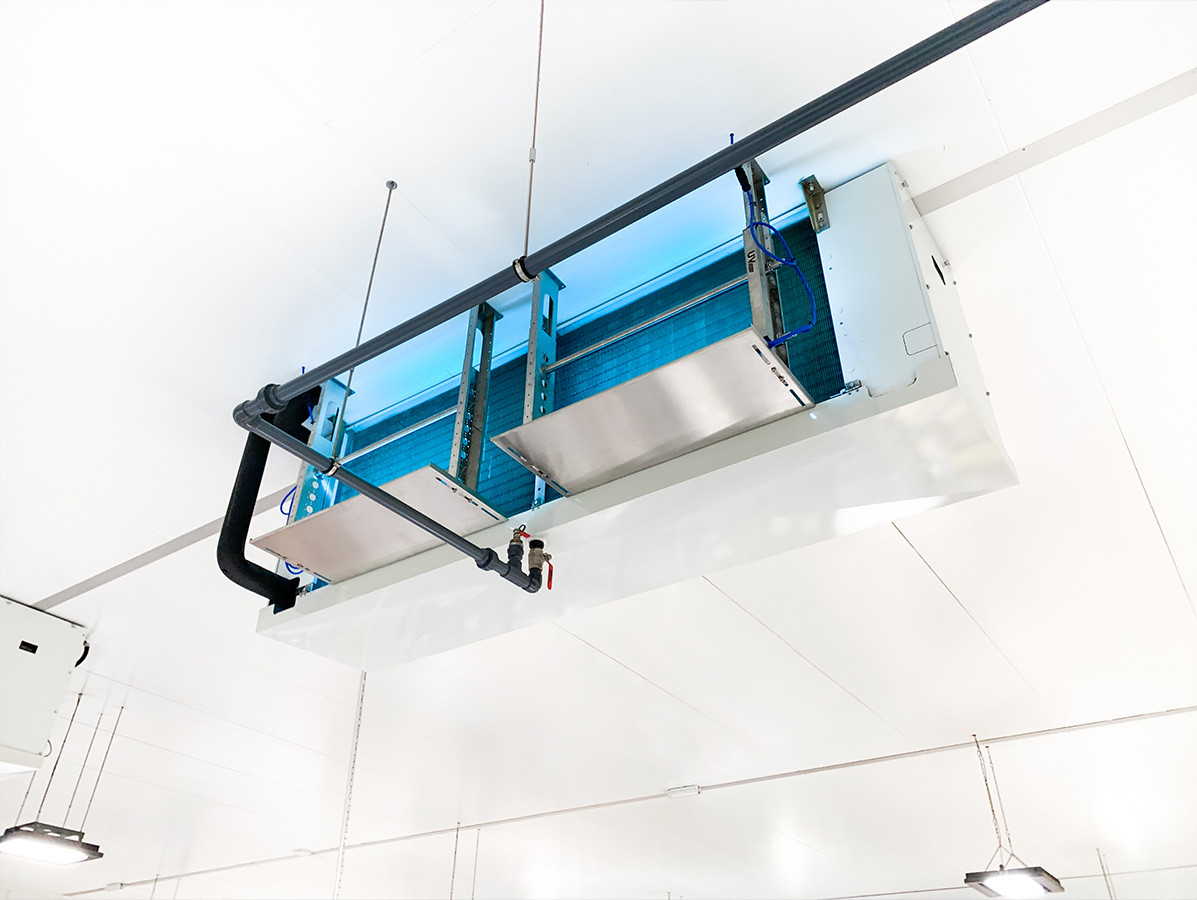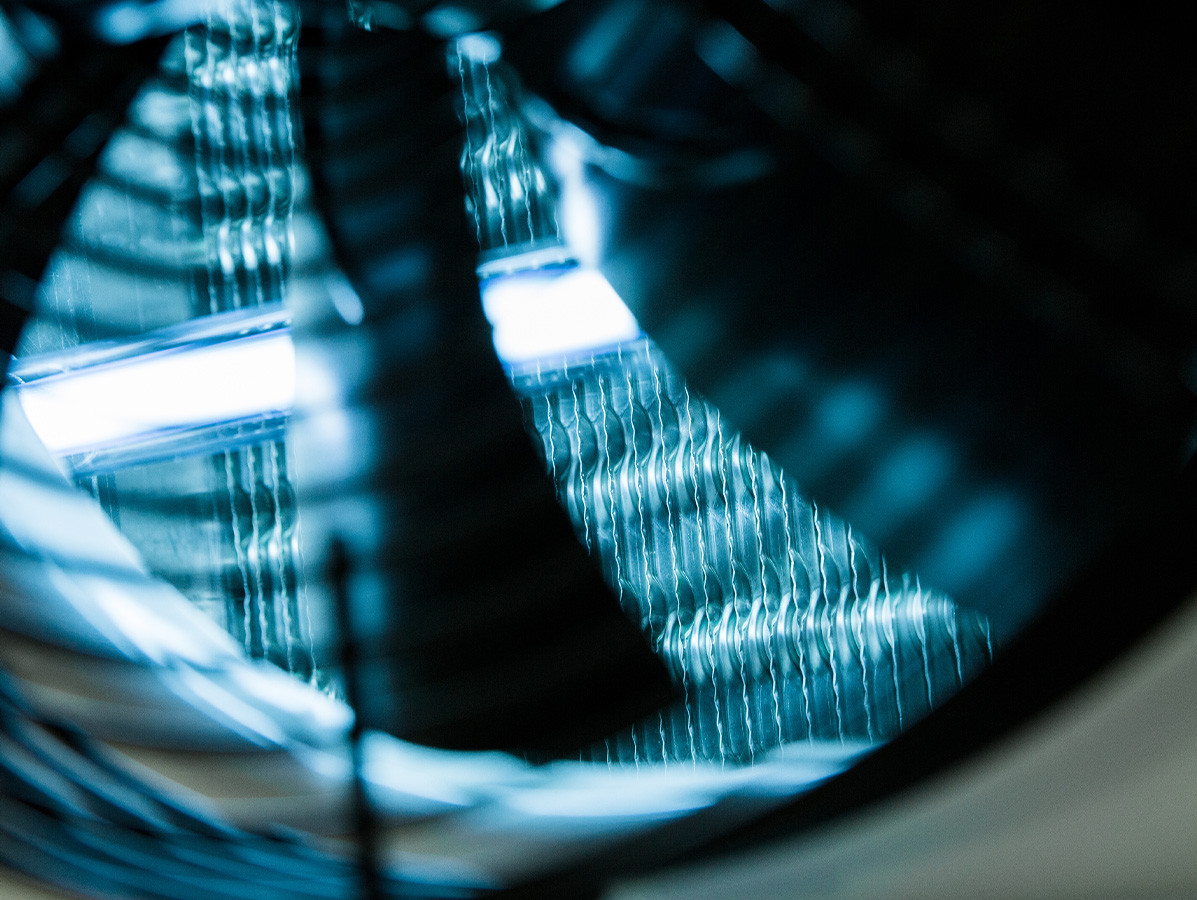
In most refrigeration, freezing and production rooms, evaporators are installed on the ceiling. These might look clean and hygienic on the exterior, but are heavily contaminated on the inside. The result: contamination risks. Special UVC lamps offer a solution.
In most refrigeration, freezing and production rooms in the food industry, evaporators are installed on the ceiling; they cool the room by drawing large quantities of air past the cold cooling block. The right temperature in processing and storage areas is obviously important to keep microbiology under control. But the fact that microbiological risks also arise from cooling air is something we are not as aware of. The biggest risk from an evaporator is Listeria, which can survive well in cold environments. Especially sensitive to contamination are production areas for ready-to-eat products, fish processing and areas with unpackaged product.
Evaporators are in operation 24/7. They are usually inspected infrequently. Regular cleaning is necessary, but very difficult in practice; partly because they are often difficult to reach because of the height as well as the machinery positioned underneath. Martijn van Klink, owner of Bioclimatic together with his father Bert, regularly visits food processing companies. He knows the risks surrounding evaporators. "Evaporators that look clean and hygienic on the outside can mislead you. On the inside, on the evaporator fins, small droplets of condensation moisture form as a result of the cooling process. This gives microorganisms enough water to thrive. A slimy layer forms on the fins and in the dripping tray: biofilm. After just a few days, a stable germ flora has developed on and in a new evaporator, which can reproduce well even at low temperatures on cooler fins."

Bioclimatic specialises in disinfection equipment for the food industry. One proven disinfection method that has been the subject of much scientific research is the use of UVC light. "UVC light works against all types of micro-organisms," Martijn continues. "It has been used for disinfection since 1908. This light actually damages the DNA of micro-organisms and viruses, preventing them from multiplying. Resistance does not occur with this form of disinfection." Ultraviolet light or ultraviolet radiation is invisible. It has a shorter wavelength than visible light. UVC lamps do produce a visible blue light as a by-product." For installation, there are two options: built-in and pre-built with a frame. The first option is possible for double-sided blow-out evaporators, evaporators with airsocks and evaporators with sufficient space. The second option is applied to evaporators on the intake side. "With the relatively simple intervention of fitting or pre-fitting UVC lamps to existing evaporators, you avoid the previously mentioned risks in one fell swoop," says Martijn. "The fan is rotating anyway; an existing air cooler thereby changes from a risk factor to an air cleaning device."
UVC radiation is categorised as 'artificial optical radiation'. When exposed, it is harmful to skin and eyes. This is why European directives apply. This is necessary to ensure the safety of people working in the rooms where the lamps are installed. "Evaporators with UVC light must be equipped with an operating switch and sufficient warnings so that technicians know that the light must be switched off before they can carry out any work. Shielding the light is also important; if people are working in the room every day, no UVC light should escape from the evaporator. This sometimes requires additional shielding. If necessary, the UVC lamps can be switched on only in the absence of people. When in doubt, we take measurements to ensure a safe workplace. Incidentally, the height at which the evaporator has been installed is also important. As a rule, it is not possible to make a safe installation if the evaporator is placed at three metres or lower."

Bioclimatic uses food-safe UVC lamps in the food industry. "These UVC fittings are waterproof (IP68) and corrosion-resistant. The PTFE sleeve around the UVC tubes ensures that no glass shards or splinters are released if the glass is broken."
When installing UVC lamps in an evaporator, the fins and drip tray are illuminated 24/7. "Here, totally no more bacterial or fungal growth is possible," Martijn guarantees. "But the contact time with the passing air is short," he nuances. "So it is not the case that the air is free of micro-organisms at once. It takes a number of passages, or contact moments, with the air to disinfect the room with reasonable effectiveness. As a general rule, we use a period of one to two hours after a contamination before the contamination in the air is neutralised."
By illuminating the evaporator with UVC light, eventually no more fungi, bacteria and yeasts grow on it. As a result, it does not need to be cleaned as often, as this keeps it free of biofilm. Biofilm also insulates the fins and cooling pipes, reducing the evaporator's efficiency. A clean evaporator not only reduces the risk of contamination, but also the energy consumption of your cooling system."
Source: Vakblad Voedingsindustrie 2023